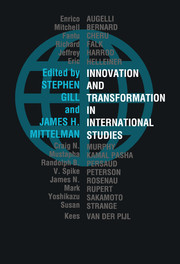Book contents
- Frontmatter
- Contents
- List of contributors
- Preface
- Acknowledgements
- Part I Rethinking and remaking the roots of global social and political theory
- 1 Transformation and innovation in the study of world order
- 2 Consciousness, myth and collective action: Gramsci, Sorel and the ethical state
- 3 The critical realist tradition and the demystification of interstate power: E. H. Carr, Hedley Bull and Robert W. Cox
- 4 Ibn Khaldun and world order
- Part II Political economy: the social and ecological anatomy of transformation
- Part III Transformation, innovation and emancipation in global political and civil society
- Part IV Reflections on global order in the twenty-first century
- References
- Index of names
- Index of subjects
1 - Transformation and innovation in the study of world order
Published online by Cambridge University Press: 05 July 2011
- Frontmatter
- Contents
- List of contributors
- Preface
- Acknowledgements
- Part I Rethinking and remaking the roots of global social and political theory
- 1 Transformation and innovation in the study of world order
- 2 Consciousness, myth and collective action: Gramsci, Sorel and the ethical state
- 3 The critical realist tradition and the demystification of interstate power: E. H. Carr, Hedley Bull and Robert W. Cox
- 4 Ibn Khaldun and world order
- Part II Political economy: the social and ecological anatomy of transformation
- Part III Transformation, innovation and emancipation in global political and civil society
- Part IV Reflections on global order in the twenty-first century
- References
- Index of names
- Index of subjects
Summary
As the births of living creatures at first are ill-shapen, so are all innovations, which are the births of time.
(Bacon, 1625)This chapter explores the question of innovation as a prelude to reconstruction of theories of structural change and world order. A central goal is to integrate ‘social’ and ‘international’ theory, to transcend their limitations and to generate a theory that can help to illuminate and explain the present global transformation. This mandates ‘critical innovation’. Such innovation involves exploration of sources as well as potential for theoretical development. With these aims in mind, the chapter makes the following arguments:
1 Critical innovation mandates ongoing questioning of and challenges to orthodoxy and the construction of an alternative problématique, one that is not only ‘international’ but also ‘global’.
2 Critical innovation requires a historical perspective, drawing upon the imaginations of historians and critical theorists of the past. This can help to illuminate the dialectic between the long-lasting social and mental patterns of the longue durée and the forces of transformation. In this way, for example, Fernand Braudel's work helps to outline the limits of innovation and the weight of continuity in world orders.
3 Our ability to innovate can be improved by a comparative historical method. By making comparisons, for example, between the transformations in world order of the nineteenth and twentieth centuries, in the longer time frame of modernity, we can better assess the novelties of contemporary metamorphoses. We can then ask, ‘what aspects of present-day change are contingent, and which are structural?’
[…]
- Type
- Chapter
- Information
- Publisher: Cambridge University PressPrint publication year: 1997
- 14
- Cited by



